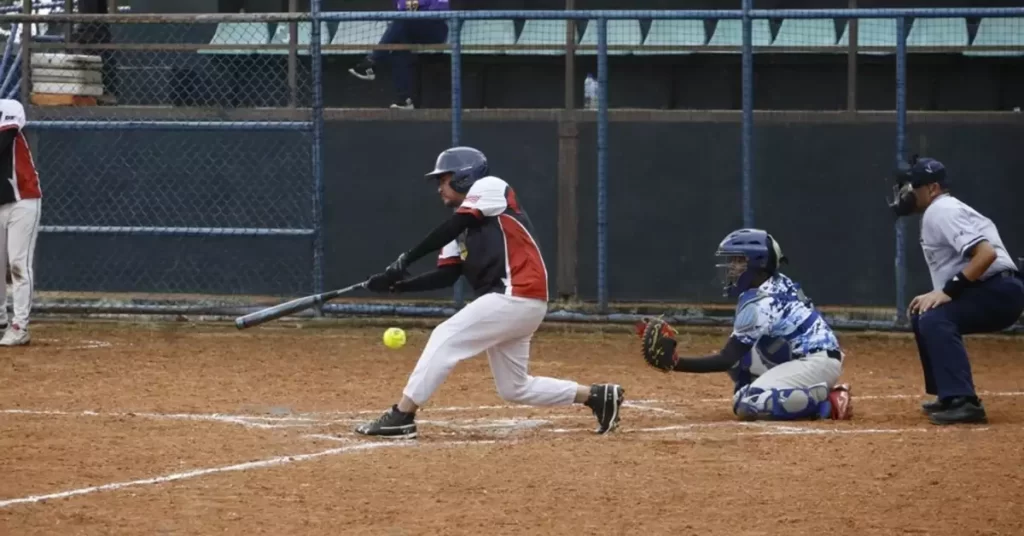Softball, a sport filled with strategies, skills, and excitement, never fails to surprise both players and spectators alike. Bunting, one of the most effective offensive moves, often leaves the defense in disarray. With its versatility, many players wonder about the practicality of bunting with two strikes on the scoreboard.
Yes, it’s possible to bunt with two strikes in softball, but it carries a significant risk. If the bunt attempt results in a foul, the batter will be called out, making it a high-stakes decision for players and coaches alike.
So, why consider bunting with two strikes? Weighing the potential benefits against the risks can make all the difference in the game. Unveil the secrets behind this daring strategy and learn how it could give your team the winning edge in the most crucial moments. Dive into the thrilling world of softball and explore the art of bunting with two strikes!
Understanding Bunting
What is Bunting?
Bunting is a unique batting technique in which the batter holds the bat horizontally and loosely, allowing the ball to make gentle contact.
The goal is to place the ball into play within the infield, forcing the defense to make a difficult and quick play. When executed properly, bunting can lead to a base hit or a sacrifice play that advances the runners.
Why Bunt in Softball?
Bunting is a strategic move that can provide several benefits to the offense, including:
- Advancing runners into scoring position
- Catching the defense off-guard
- Utilizing the batter’s speed
- Forcing errors from the defense
- Disrupting the pitcher’s rhythm
Bunting Rules
Bunting with Two Strikes
According to official softball rules, bunting is allowed with two strikes. However, if a batter attempts to bunt with two strikes and the ball goes foul, it is counted as a third strike, resulting in a strikeout. This rule discourages batters from bunting with two strikes due to the increased risk of striking out.
Foul Bunts and Strikes
In softball, a foul bunt occurs when a batter attempts to bunt but the ball lands in foul territory or goes out of play. Foul bunts count as strikes, and as mentioned earlier, a foul bunt with two strikes results in a strikeout.

Bunting Techniques
Sacrifice Bunt
A sacrifice bunt is a strategic play where the batter intentionally bunts the ball to advance a baserunner, sacrificing their own opportunity to reach base. The batter aims to place the ball in a difficult position for the defense, allowing the baserunner to advance while the batter is thrown out at first base.
Drag Bunt
A drag bunt is a more aggressive bunting technique designed to catch the defense off-guard and result in a base hit for the batter. The batter, typically a fast runner, starts to sprint towards first base as they make contact with the ball.
The goal is to place the ball softly in the infield, forcing the defense to rush their throw, often resulting in a safe call at first base for the batter.
Push Bunt
A push bunt is a variation of the drag bunt, where the batter attempts to bunt the ball towards the right side of the infield. This technique is particularly effective against left-handed pitchers and when there’s a slow runner on first base. By pushing the ball to the right side, the batter aims to create confusion and force errors from the defense.
Bunting Strategy
When to Bunt
Choosing when to bunt depends on several factors, such as game situation, batter’s speed, defense positioning, and pitcher’s performance. Some common scenarios to consider bunting include:
- Late in a close game with a runner on base and less than two outs.
- When facing a dominant pitcher, and scoring opportunities are limited.
- When the defense is positioned deep, leaving open spaces in the infield.
- When the batter is a fast runner, increasing the chances of reaching base on a bunt.
Defensive Reactions to Bunts
Defensive players must react quickly and decisively when the offense attempts a bunt. Key defensive reactions include:
- Charging the ball aggressively to minimize the time the batter has to reach base.
- Communicating with teammates to ensure someone covers the base where the runner is advancing.
- Prioritizing getting an out, even if it means allowing the batter to reach base safely.

Bunting Drills and Practice
To master bunting, players should practice regularly and focus on the following aspects:
- Proper bat angle and grip.
- Timing and positioning in the batter’s box.
- Reading pitches to determine which ones are suitable for bunting.
- Executing various bunting techniques and strategies.
Common Bunting Mistakes
Avoiding common bunting mistakes can significantly improve a player’s bunting success. Some frequent mistakes include:
- Jabbing at the ball instead of catching it with the bat.
- Holding the bat too tightly, resulting in less control.
- Not squaring up to the pitcher early enough, telegraphing the bunt attempt.
- Bunting pitches outside the strike zone, increasing the risk of fouls and strikeouts.
Bunting in Different Softball Leagues
Bunting rules and strategies can vary across different softball leagues and levels of play. It’s essential for players and coaches to understand their league’s specific rules and adapt their bunting strategy accordingly.
FAQs
Can you bunt in slow-pitch softball?
Generally, bunting is not allowed in slow-pitch softball, as most leagues prohibit it. However, rules may vary depending on the league or tournament, so it’s essential to verify the regulations before attempting to bunt in slow-pitch games.
What is the difference between a bunt and a slap in softball?
A bunt is a technique where the batter gently taps the ball into play, aiming to place it in a challenging position for the defense. A slap is a modified swing used by left-handed batters to make contact with the ball while running towards first base. Both techniques are designed to put pressure on the defense and utilize the batter’s speed.
Can a batter be called out for stepping out of the batter’s box while bunting?
Yes, if a batter steps out of the batter’s box while making contact with the ball during a bunt attempt, the umpire can call the batter out for an illegal action.
Final Verdict
Bunting is a strategic and valuable tool in the game of softball. While bunting with two strikes is allowed, the risk of striking out on a foul bunt makes it a high-stakes decision.
Mastering bunting techniques and understanding when to use them can significantly impact a team’s offensive success. As a player or coach, it’s crucial to practice bunting regularly and adapt strategies based on the specific rules of your softball league.
